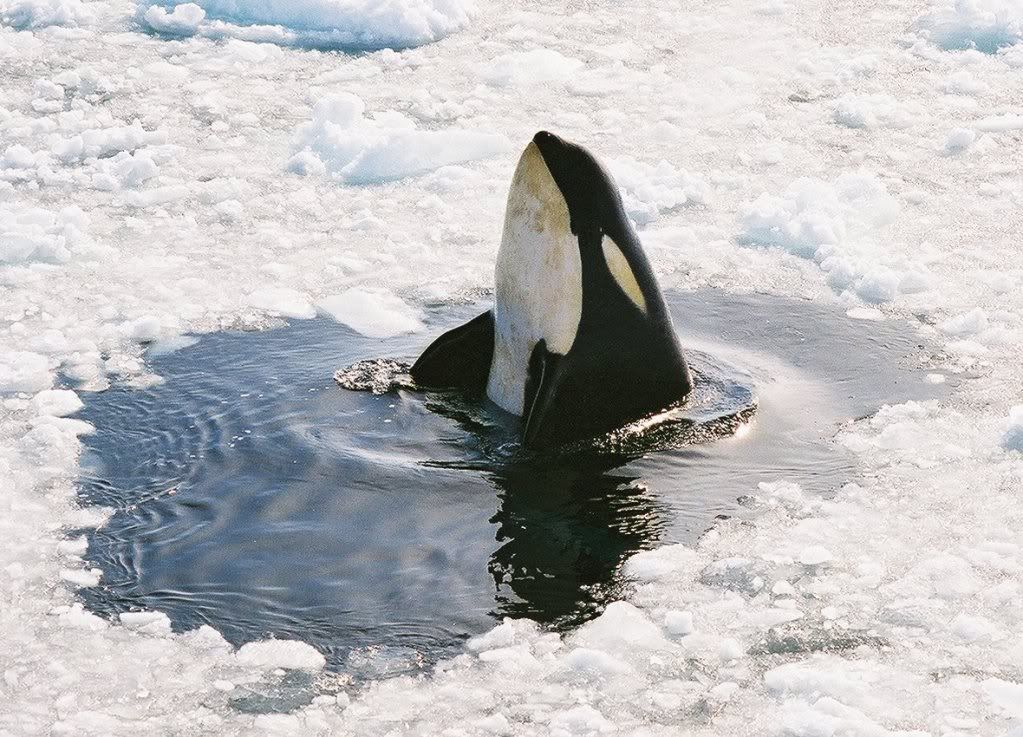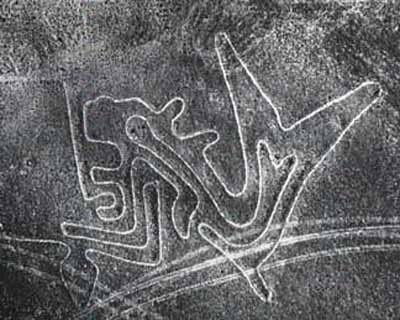
Above: Orcinus orca spyhops in the wild.
Orcinus Orca & Orca Incident
Now the Sea World orca incident is old news to most people but certainly not for the family, friends, and colleagues of Dawn Brancheau.
One of the things that fascinated me about the whole thing was how both the public and media seemed so disconnected to just what the creature, Orcinus orca actually is.
So I thought I would give you some information about the species.
Orca Enters Our Awareness
Early references to the orca include one, circa 50 CE, when Pliny the Elder shared an account of the public slaughtering of a killer whale stranded in the harbor at Ostia near Rome.
One of the earliest published reference to the species refers to “an enormous mass of flesh armed with savage teeth” and “the enemy of other whales [who does] charge and pierce them like warships ramming.”
 By 100 BCE, the Nazca Natives of Peru used killer whale designs as symbols of power, courage, and fertility, and built temples dedicated them.
By 100 BCE, the Nazca Natives of Peru used killer whale designs as symbols of power, courage, and fertility, and built temples dedicated them.
For the science fiends, the species was first identified in 1758 by Carlos Linnaeus.
However, ocean faring folks were familiar with orcas because during the modern whaling practices of the 19th century orcas were reported to be joining whaling boats or assisting whalers.
Orcas helped whalers in their efforts, the most famous being the Eden pod (Australia) and the whaling Davidson Family.
Although there are a lot of theories about why orcas began to be called killer whales, it was thought that it actually originated from the Latin scientific name roots.
Orcinus, (bringer of death) and Orcas (lower world)
This is thought to have morphed with the common reference from seafarers.
Mariners and whalers observed transient orcas eating other whales and so referred to them as “whale killers.”
Subsequently it was thought that the moniker was revised to “killer whale.”
Now it wasn’t until the 1960s that captive orcas came into the public awareness and at that time people still thought of whales and dolphins as fish.
Marineland was one of the earlier marine parks and first attempted capturing whales in 1961 but the first captive killer whale to be successfully exhibited was not until 1964.
This animal, Moby Doll, was captured by the Vancouver Aquarium collectors and kept in an ocean pen in the Vancouver harbor, surviving a short three months.
The next exhibited killer whale, Namu, was in 1965. Accidentally caught in a gill net, he was purchased by the Seattle Aquarium and was the first captive orca to perform for the public.
He lived eleven months.
Marineland’s whales, Orky and Corky, were members of a specific resident pod of orcas in British Columbia known as A5.
Orky was captured in 1968, while Corky was captured and brought to Marineland in 1969.
During that period of time, Dr. Michael Bigg pioneered field research on orcas beginning in the early 1970’s and shortly after the photo identification and cataloging of individual animals began.
In 1971 that the Marine Mammal Protection Act came to be and then regulations put into place concerning the capture of orcas in the United States so that permits were to be obtained before capturing one.
So, until the early 1970s not much was known about them.
Introduction to the Orca or Killer Whale
The orca, still known more popularly as the killer whale, has the scientific name of Orcinus orca and they are actually the largest dolphin within the Delphindae family.
Depending on the ecotype, orcas can live in family groups of anywhere from 2-40 animals–although schools of up to 250 have been reported in the literature.
It is estimated that there are at least three recognizable types of killer whales called, residents, transients, and offshores.
Each of these ecotypes does not associate with members of the other groups.
The group animals vary by having different home ranges, vocalizations, dietary preferences, foraging patterns, outward appearances/features, and genotypes.
In general, the resident orcas prey mostly on fish, while the transient orcas prefer marine mammals and the offshore orcas feed on both types of prey.
Orcas are form communities, pods, subpods, and matrilineal groups.
- Orca Community is made up of orcas that share a common range and are associated with one another.
- Orca Pod is a group of orcas within an orca community that remain together while traveling the majority of time.
- Orca Subpod is a group of individual orcas that temporarily fragments from the pod to travel.
- Matrilineal Orca Group are individuals within a subpod that travel together in close proximity. Usually these groups contain multiple generations of the same family.
The social structure of transient orcas are the least understood but it is known that they live in smaller matrilineal groups whose members will leave for extended periods (or permanently).
Smart, Skillful Predators
If you watched the video I put up earlier this week you probably were astounded by the strategy used to dislodge the seal from the ice flow.
That’s the thing about orcas–they are smart and creative.
When it comes to prey they use a variety of strategies to hunt.
Now you might have seen footage of them coming onto shore to scare seals into the water and how they pulverize those animals they intend to eat.
A wild orca is estimated to eat up to somewhere around 400-500 pounds of food per day while captive orcas at Sea World are reported to receive 140 to 240 pounds of herring, capelin, salmon, mackerel, etc, daily. Captive animals don’t need as much food for a variety of reasons.
But in the wild orcas burn a lot of calories and they have a lot of different techniques for hunting and also experiment.
Wild Orca Attacks on Humans & Other Incidents
Now the other misconception concerns the claim that outside of captivity that killer whales have not attacked humans, this is incorrect.
The first documented incident I came across was in, The Worst Journey in the World: Antarctic 1910–1913 which details an expedition in the early 1900s.
A group of orcas actually is breaking up the ice to get at a dog team and photographer standing on it. This was disconcerting to the group, but they survive and you can read the account online.
Now I didn’t get to do all the research I wanted, but did discover that there was a diver who was attacked up in Santa Cruz around July 22, 1969.
Here in California, I know of an orca incident that involved a surfer by the name of Hans Kretschmer who was bitten by a wild orca in 1972 up at Point Sur. He managed to get to shore but was left with 100 stitches and scars.
This incident was written up in 1975 (Snorf, Hughes, Takashi of Pacific Grove Marine Rescue Patrol in the Journal of Bone & Joint Surgery).
The paper was titled, Killer Whale Attack on Surfer: A Case Report and was also referenced in the San Francisco Examiner (11 September 1972, p 16. Report of probable killer whale attack.)
In my search for the Canadian diver that died after an orca incident in 1986 (which I could not substantiate), I found that apparently orca and diver incidents off the coast of Australia have been reported numerous times.
But probably the most recent headline was the Wild Killer Whale Incident (August 2005) that involved a boy in Alaska who was bumped by a killer whale but survived unscathed.
So I hope this post has helped you to discover more about Orcinus orca and has clarified a few misconceptions about the creature.
I have more that I want to discuss but it is going to have to wait until later in the week!
If you have something to add, or have a resource I might have missed, please leave your comment below.


Hello,
First of all I would like to apologize for my incorrect english.
I would like to say that although these incidents you commented here actually ocurred, no human has been killed by a wild orca, and due to the fact that some populations of orcas in the wild are in close interaction with humans, we can conclude this animals are not agressive to humans when in the wild.
However in captivity, the amount of incidents/attacks are inmense in comparison to the amount of orcas that have been kept in a pool.
I have to say as well that what we know about the incidents in captivity is probably a very short amount of cases and more research should be done in that aspect in order to have a wider idea about what is happening in this establishments.
Best,
It is to my understanding that in the Hans Kretschmer incident it was initially thought to have been perpetrated by an orca but later after examining the bite marks, it was determined that the culprit was in fact a shark not killer whale. Which makes sense because the article you cited states that the bites looked as if it was done by an axe, sharks have teeth made for cutting and shredding which are flat, sharp and dispensable because of the tremendous wear they endure while orcas have teeth made for grabbing that are dull, primate and cone shaped. The descriptions of the attack that I looked up also sound shark like as well, one quick inquisitive bit, retreat then come back for the fatal bite where as a killer whale (when hunting seals) hits hard and fast and doesn’t let go.
Please correct me if I’m wrong.
I’ll have to confer with some of the marine mammal researches I know but the last account reported in 1996 indicated that it was confirmed as an orca and the guy who was attacked said he turned around and was staring into the face of an orcinus orca and not a shark.
Thanks for stopping by Andrea. Actually, no documented wild kills is different from no human has ever been killed. I don’t agree with your conclusion based on my long term experience with both wild and domestic animals both in the wild and in captivity.
In captivity, encounters and interactions are intense and much more frequent than wild encounters with orcas. Also, I think it is more telling that there haven’t been more incidents just based on the size of the animals and interactions.
I think the important point I want to highlight is that people want to believe wild animals are benevolent creatures instead of seeing them as large predators or wild animals responding and reacting as such.
Appreciate your taking the time to comment and thanks for sharing your option. I agree that a lot has to change AND research on all levels is seriously needed especially since most of what we know has only arisen since about the 1960s.